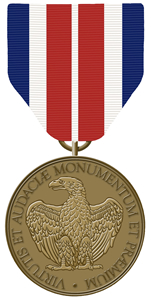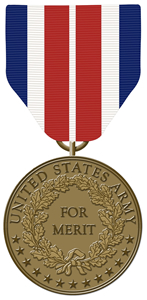 |  |
Robert L. Ampula
Administrative Officer
U.S. Army Medical Department Regiment
The United States has recognized Soldiers for distinguished merit or acts of valor since the birth of our nation. However, unlike the many awards we have today to recognize these achievements, the first century of our existence offered few choices.The first of the nation’s awards was the Fidelity Medallion created by an act of the Continental Congress in 1780. It was also referred to as the Andre Capture Medal and it was established for award to those Soldiers who assisted in the capture of Major John Andre of the British Army. Andre was subsequently executed as a spy for his part in Benedict Arnold’s attempt to surrender the fort at West Point. The medallion is not often considered the first award for distinguished merit because it was created to recognize participants of a singular event, never to be issued again. The medallion was presented to only three Soldiers before its disuse.
The second award, therefore, is most often credited as the original award for military merit. This award was established by General George Washington in 1782 and designated the Badge of Military Merit. General Washington wanted to inspire ambition and foster military merit and thus authorized the badge in the figure of a heart in purple cloth or silk. The badge was only awarded to three Soldiers before passing into history with the end of the Revolution. The Badge was revived in Feb of 1932 and is now recognized as the Purple Heart. After the American Revolution, it would be over fifty years before another award for valor or distinguished merit would appear.
The Certificate of Merit followed the two short lived Revolutionary War recognitions and takes its place in history as the third award for distinguished merit in the history of the United States. The Certificate of Merit began during the Mexican War in an Act of Congress on March 3, 1847 followed rapidly by War Department General Order number 9 dated 10 March 1847. Although it is unknown precisely why the Certificate of Merit was established, the General Order offers some clues. The order increased the size of the Army by ten regiments to assist in the execution of the Mexican War. In addition, this order contains a number of provisions that appear to be incentives for enlistment and retention. Among these provisions was a way to reward non-commissioned officers and Privates who distinguished themselves.
The act stated that non-commissioned officers who distinguished themselves could be rewarded with brevet promotions to the lowest grade of commissioned officer. The act also provided that “… when any private soldier shall so distinguish himself the President may in like manner grant him a certificate of merit, which shall entitle him to additional pay at the rate of two dollars a month.” This was a significant amount of money at the time. Some state volunteers appear to have been paid only $7 a month in the Mexican War and consider that 14 years later during the Civil War, a Private was only paid $13 a month. There were no known medical Soldiers awarded the Certificate of Merit among the 539 certificates issued for actions in the Mexican War. It is possible that officers were not specifically mentioned in this act because they could already be rewarded with brevet promotions.
With the end of the Mexican War it was generally assumed the Certificate of Merit had run its course and it went into disuse much as its predecessors. That is not to say that recommendations were not submitted, only that none were acted upon, probably in the belief that the award was only for the Mexican War. In addition, the introduction of the Medal of Honor during the Civil War provided a means to recognize gallantry although there was no monetary reward. After the Civil War and during the early part of the Indian War there were, again, no certificates of merit awarded. It wasn’t until after the Battle of the Little Big Horn in 1876 that action to reinstate the Certificate of Merit was approved.
The Adjutant General’s office published General Order 110 on 6 December 1877 announcing the reinstatement of the Certificate of Merit and it established 22 June 1874 as the earliest date of actions for which awards of the Certificate could be submitted. At least two certificates were awarded for actions prior to this date as evident in The Official Army Register for 1901, published by order of the Secretary of War by the Adjutant General’s Office December 2, 1900. The register lists a certificate of merit for Private Daniel O. Drennan for distinguished courage, perseverance and fidelity in carrying dispatches from Fort Trotten to Fort Stevenson, Dakota, through a country infested by raiding parties of hostile Indians in 1870, and for saving, at the risk of his life, valuable public records from destruction by fire in Chicago in 1871 while serving as private, general service. The second was for Sergeant John Nihill for gallantry in action against hostile Apache Indians at the Whetstone Mountains, Arizona, July 13, 1872 while serving as private, troop F, 5th cavalry. These anomalies aside, June 22, 1874 was established as the earliest date for which the certificate could be awarded.
In 1891 eligibility was expanded from privates to any enlisted man. Unfortunately, actions that were noteworthy but were not in action against an enemy of the United States could not be recognized using a strict interpretation of the criteria for the Certificate of Merit. Those criteria would be expanded and further defined the following year. The similarities between the Medal of Honor and the Certificate of Merit were evident and some individuals were awarded both for the same action.
1892 saw a change in criteria for award of the Certificate of Merit. Adjutant General’s Circular number 2 dated 11 February 1892 states “Medals of honor should be awarded to officers or enlisted men for distinguished bravery in action, while certificates of merit should, under law, be awarded for distinguished service, whether in action or otherwise, of a valuable character to the United States as, for example, extraordinary exertion in the preservation of human life, or in the preservation of public property, or rescuing public property from destruction by fire or otherwise, or any hazardous service by which the Government is saved loss in men or material. Simple heroism in battle, on the contrary, is fitly rewarded by a medal of honor, although such act of heroism may not have resulted in any benefit to the United States. Where the conduct of an enlisted man, non-commissioned officer or private has been represented to merit both a medal of honor and a certificate of merit, recommendation may be made for both, either simultaneously or at different times.”
The one drawback to the Certificate of Merit was there was no way to visually identify individuals who had received the certificate. That was rectified with War Department General Order No. 4 dated 11 Jan 1905. That order announced a system of badges (medals) including one to represent the Certificate of Merit.
During World War I General Pershing, Commander in Chief of the Expeditionary Forces in France, noted that our allies were using decorations to recognize gallantry and outstanding service by senior officers while in the field. The United States had only the Medal of Honor and the Certificate of Merit and their approval level was far above the immediate commander. General Pershing recommended that recognition other than the Medal of Honor, be authorized for the Armed Forces of the United States for service rendered, in like manner to that awarded by the European Armies. President Woodrow Wilson concurred and two new decorations were approved by an Act of Congress 9 July 1918, the Distinguished Service Cross for gallantry and the Distinguished Service Medal for meritorious service in a position of great responsibility.
Since the criteria for the new awards were similar to the Certificate of Merit, the certificate was discontinued by this same act. The act provided that the holders of the Certificate of Merit should receive the Distinguished Service Medal in lieu of their Certificate of Merit and the additional pay of $2 a month for the Certificate of Merit would cease upon issue of the Distinguished Service Medal. However, the act further authorized an additional $2 a month for recipients of the new decorations. It should also be mentioned that this act established a citation star which would later become the Silver Star.
One final footnote to the Certificate of Merit came on March 5, 1934 in an Act of Congress. The act stated “That the Distinguished Service Cross shall be issued to all enlisted men of the Army to whom the certificate of merit was issued under the provisions of previously existing law in lieu of such certificates of merit.” It went on to additionally state “Those persons who have heretofore received the Distinguished Service Medal in lieu of the certificate of merit under the provisions of the Act of July 9, 1918 (40 Stat. 870-872), shall be issued the Distinguished Service Cross provided the Distinguished Service Medal is first surrendered to the War Department .” One can only conclude this provision was added because Certificates of Merit were issued for gallantry and not for distinguished service in a position of great responsibility. There were four known AMEDD Soldiers who received the Distinguished Service Cross in lieu of their previously awarded Certificate of Merit/Distinguished Service Medals.

